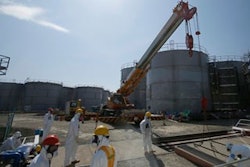BROOKSTON, Ind. (AP) — The pigs are coming. That much is almost certain. More than 9,000 of them, packed together in a huge warehouse in White County, pumping out as much bodily waste each year as the entire human population of Greater Lafayette.
What no one yet knows is just how bad they will smell, how much runoff they may produce and how neighboring property owners will be affected.
If the best hopes of John Erickson, the farmer who is building the facility, and state and local regulators and pork industry officials are realized, the impact will be minimal, and worth the benefits to society at large in terms of lower pork prices at the supermarket.
But if the worst fears of some environmentalists and industry experts come to pass, neighbors such as Camp Tecumseh, David Krause and Janet Rose could see their enjoyment of their properties overwhelmed by the stink and the mess.
Krause and his wife purchased 67 acres just southeast of the proposed hog operation years ago for their retirement. An architect has drawn plans for their dream home at White County Road 1025 South and Springboro Road.
But now Krause doubts that dream will ever materialize.
"If Erickson could keep his dust and his smell and his water on his property, no one would care," Krause told the Journal & Courier, "but he cannot guarantee that."
Janet Rose and her husband, Louis, own a house in Walnut Ridge subdivision in White County, a neighborhood just west of the Tippecanoe River and north of Indiana 18.
Rose's house is less than a mile from where Erickson wants to build the concentrated animal feeding operation, or CAFO, capable of housing up to 9,240 hogs. The size of the operation and nearness to her neighborhood, and to Camp Tecumseh just east of Walnut Ridge, worry her.
"I like the Ericksons, and they're good people," said Rose, who has lived in Walnut Ridge since 2005. "My worries are about the land and the air and the pollution and the road . bringing all the trucks through here."
Tecumseh, a 600-acre YMCA camp, has been host to outdoor activities for 5,000 campers during warm summer months for 90 years. Another 25,000 adults, including church groups and corporations, use facilities at the natural setting each year.
Ever since the White County Board of Commissioners voted July 1 to rezone 7 acres of Erickson's land from general agriculture to agricultural industry, Camp Tecumseh's board members have been weighing their options, which include legal action.
The conflict brewing in this corner of southeast White County is not unique. Battles over expanding hog operations have been fought all across Indiana and the Midwest.
The White County case is just the latest and highest profile example of market forces in the meat industry that are pressuring farmers to reduce costs by concentrating more pigs under one roof, even if it means going against longtime neighbors.
Can consumers and CAFO's coexist? It depends on who's doing the talking.
Mike Smolek is a White County hog producer who knows exactly what Erickson is up against, both in his struggle with neighbors and the struggle to stay viable.
Smolek also is one of seven White County Area Plan Commission members who, in a 7-2 vote on June 10, recommended that the board approve Erickson's rezoning request.
Smolek works alongside his dad, mom and two brothers on the family-run hog, crop and grain milling operation near Idaville. Smolek's father, Ray, owns 37 hog barns near Idaville that produce 120,000 hogs a year.
Odors emanating from gestation and farrowing barns are not overwhelming but grow more noticeable as visitors walk closer.
Industry changes, Mike Smolek said, have dictated the push to build large barns where thousands of animals — beef, dairy, poultry, sheep — are raised in controlled environments. Such environments reduce costly diseases, produce economies of scale, and put meat on the table at the least cost. To stay in business, a farmer has little choice but to grow bigger, he said.
"There are no more mom and pops, because they didn't have the economies of scale. No bankers will loan money unless the animal operation fits their system, and the meatpackers want the product to fit their system. We're basically a piece of the puzzle," Mike Smolek said.
Half of the hogs the Smoleks raise are contracted for sale to Indiana Packers Corp. in Delphi.
"Contract buildings help us sustain the operation," Smolek explained. "There's not enough money to build a building. The only way into this business is through a contract with a packer."
Chris Hurt, an agriculture economist at Purdue University, said the corporate structure of livestock production changed in the late 1990s when producers and banks suffered massive losses.
"The pork industry is now controlled by relatively few very, very large companies," Hurt said.
"The packers contract with the family farmers to build the buildings and care for the hogs according to the specifications of the owner, and the hogs are marketed when the packer tells them to."
Smolek summarized the relationship this way: "They own the pigs. We own the buildings, kind of like hotel contracts. Someone from there comes through our property every day and looks at the charts to see the air temperature, the feed, the medicines, death loss. It's all recorded."
But raising thousands of hogs, cows or chickens under one roof breeds significant concern for some neighbors and environmentalists.
The Hoosier Environmental Council has been holding workshops in counties with high concentrations of CAFOs to educate residents about the legal process of zoning, permitting and regulating production facilities. One recent workshop was conducted in Delphi about the time White County approved Erickson's zoning request.
"We may still be getting CAFOs, but it's important for people to know what their legal rights are so they can exercise them," said Kim Ferraro, an attorney with Hoosier Environmental Council. There are several different paths neighbors can take in court. For example, Ferraro said residents may ask a court to review local government zoning decisions, they can file a petition stipulating specific reasons why a zoning decision is illegal, or they can file suit seeking a declaratory judgment.
Ferraro cited research conducted by the Pew Commission on Industrial Farm Animal Production, which studied health and environmental impacts of CAFOs.
"There is absolutely no doubt, based on scientific research, studies have confirmed adverse impacts on water quality," Ferraro said. "High elevations of E. coli, phosphorous and nitrogen get into our water.
"When you concentrate 7,000 hogs in one building, they produce 14 times as much waste as humans."
That is equivalent to the human waste annually generated by 98,000 people — nearly the combined populations of Lafayette and West Lafayette.
"It's a small city of waste being produced, and there is no requirement that waste be treated before it is placed in the environment," Ferraro said.
According to the journal Environmental Health Perspectives, "... generally accepted livestock waste management practices do not adequately protect water resources from contamination with excessive nutrients, microbial pathogens and pharmaceuticals present in manure in the waste." The article was published in February 2007 and was based on the best data then available.
Environmental Health Perspectives is a monthly journal of peer-reviewed research supported by the National Institute of Environmental Health Sciences, National Institutes of Health and U.S. Department of Health and Human Services.
Both the Environmental Health Perspectives article and the Pew study concluded that more research is needed to understand all the impacts of CAFOs on the environment and health.
Livestock producers and state regulators counter that existing laws and regulations effectively safeguard human health and the environment.
"Indiana has one of the more extensive programs because we regulate farms that are smaller than CAFOs, and a lot of states probably don't regulate . those," said Bruce Palin of the Indiana Department of Environmental Management.
"Looking at setbacks from wells, surface water, property lines, neighbor issues . Indiana probably goes beyond what most states have."
But the Hoosier Environmental Council policy on industrial livestock operations states that IDEM rules do not address health impacts of bacteria and parasites in manure, property values or quality of life issues such as noise, dust, odors and traffic.
The U.S. Environmental Protection Agency in 2003 adopted regulations for all CAFOs. For pigs, that's defined as a farm that has at least 2,500 hogs weighing at least 55 pounds or 10,000 or more hogs weighing less than 55 pounds.
Indiana enforces federal rules as well as state regulations for smaller confined feeding operations, or CFOs, defined as 600 or more hogs but fewer than 2,500.
The total number of confined and concentrated feeding operations the state regulates is constantly changing but hovers around 1,900, Palin said. About a third of the total are CAFOs.
Palin estimated IDEM annually inspects 380 of the 1,900 facilities and takes enforcement actions about a dozen times a year, with the most common violations related to paperwork such as weekly documentation of manure storage.
"For the most part, the farms do a good job and are good stewards of the land, not causing problems and trying to follow the rules and regulations," Palin said.
"An important distinction between Indiana and the federal government is the federal program does not have requirements for construction of manure storage facilities," said Palin, who is assistant commissioner in IDEM's office of land quality.
"Indiana regulates how thick the concrete has to be, the reinforcements. Specifications of soundness of the storage unit is not part of any federal regulation. Indiana also inspects during construction."
The Hoosier Environmental Council's Ferraro, however, doesn't rest assured. "There are some regulations in place, but there are no requirements to monitor streams or groundwater supplies."
The environmental group advocates additional regulation such as licensing manure applicators, requiring more distance between CAFOs and residential areas, installing methane digesters to eliminate pathogens in manure and allowing only farmers to use antibiotics when animals are ill.
Evidence of just how much regulation CAFO operators face can be found in the Smoleks' farm office inside a large metal cabinet filled with three-ring binders and folders.
"We collect all of the information, the background check on the ground, the field topography, the size of the building, the manure management plan, the operation information, all the lands we have permission to apply manure on," Smolek said.
An important piece in the regulatory chain is each farmer's plan to handle the millions of gallons of manure.
Smolek estimated his family annually applies 18 million gallons of hog manure to fields. Crops planted in those fields, chiefly corn, utilize the nitrogen, phosphorous, calcium, zinc and other nutrients in the manure. As the crops grow, they convert the nutrients into organic matter, and the farmer's fertilizer costs are greatly reduced.
Most hog CAFOs store manure in huge underground pits directly below the animals. The manure is transferred to tankers and hauled to fields where knife-like injectors push the liquid several inches below the soil surface. Regulations are aimed at allowing farmers to maximize the resource without oversaturating the ground or sending contaminants into streams.
The Smoleks test the manure and the nutrient level in the soil so they know how much to apply in specific fields. Smolek doesn't hesitate when asked about his ability to apply manure without contaminating surface and groundwater.
"If I'm poisoning them, I'm poisoning my family, too," Smolek said.
Ferraro, of the Hoosier Environmental Council, is steadfast in her concerns.
"Yes, there are technology improvements, but there are no requirements to use them," Ferraro said. "Businesses are looking for ways to reduce cost."
As of June 3, Carroll County had 97 regulated animal feeding operations, White County had 67 and Tippecanoe County had 26, Palin said.
Carroll and White counties are among the top five pork-producing counties in the state, according to IDEM and the Hoosier Environmental Council. That fact raises a flag for Ferraro and her group, which maintain that watersheds in those counties may be exposed to higher risk of contamination by non-useful ingredients in the manure such as pathogens, bacteria and antibiotics that are routinely administered to keep confined animals healthy.
The EPA and IDEM regulate air pollutants, gases and particulate material generated by many industries.
But there are no state or federal rules governing agricultural air emissions.
To minimize emissions emanating from CAFOs, researchers at the Purdue Department of Agricultural and Biological Engineering have measured the volume of dust and odorous gases in and around the barns.
Professor Al Heber developed a model to estimate the impact of CAFO odors based on barn size and design, wind frequency, topography and manure handling.
Heber evaluated the potential impact of the proposed Erickson CAFO on Camp Tecumseh and expects it will be minimal because of the three-quarter-mile distance between the proposed barns and the camp.
"I have taken measurements around a similar facility," Heber said, "and we found the odor does disperse pretty quickly once you get a half mile away."
"We measured bacteria downwind of a 6,000-head finishing facility in Carroll County, and 200 yards away the total amount of bacteria decreased down to the upwind levels."
Heber said he was glad to learn that Erickson plans to plant two rows of trees around the perimeter of the future CAFO barns.
"That may be more effective than we think," Heber said.
"Dust carries odors. The trees will intercept the dust, the dust will settle on the trees and the rains will wash that dust into the ground."
Tamilee Nennich, a Purdue associate professor of animal sciences, agreed that tree barriers and distance can reduce the amount of particulate material moving beyond farm property lines.
Smell is another story.
"A lot of it depends on how the manure is handled and stored," Nennich said.
"The storage pits can be mechanically ventilated by fans. There is research on feed additives to reduce manure odors, and there are additives to put in the manure storage areas to reduce the smell."
Smolek said he uses three odor control products in the manure pits.
— Pit Boss accelerates solids breakdown and helps lower gas production;
— More Than Manure binds nitrogen, phosphorous and potassium to make the nutrients more available to the plants. It also helps reduce odor.
— A third product is labeled for use with cows, but Smolek decided to try it. He said the jury is still out.
"If you are doing things right, it shouldn't have a strong odor," he said.
Inside the farrowing barns, which hold about 60 sows at a time, and gestation barns, which hold the sows and their litters, the smell of manure is intense but not overpowering.
Outside the barns that hold 1,000 to 2,000 hogs, the odors are more noticeable depending on wind direction and how close a visitor stands near the huge fans that pull air through the buildings.
The most recent livestock census, taken in 2007, showed 75 percent of Indiana hogs were on farms with 2,500 head or more, Chris Hurt said.
As CAFOs have accounted for more and more of Indiana's livestock production, four Purdue researchers have made a point of studying the fiscal and environmental effects and the level of community conflict.
Janet Ayres, a professor of agricultural economics at Purdue, specializes in leadership development and conflict management, worked on the 2008 study of CAFO development.
"The most sustainable approach is collaboration, where the parties work through the issue and try to address peoples' concerns," Ayers said.
"But there has to be a willingness to give up power and listen to emotions. When people display emotions, they are displaying what is important to them."
Ayres said it is rare to see conflict over CAFOs resolved without legal intervention.
"When an issue is so polarized, so emotional, collaboration is very difficult to achieve," she said.
Paula Iunghuhn and her husband, Matt, seem to be one of the few Walnut Ridge neighbors who are comfortable with Erickson's plans.
"Our initial concern was traffic on our road, and that the county would maintain the road," said Paula Iunghuhn.
"We attended the original board of zoning appeals meeting in December, and we felt our questions were answered."
Iunghuhn based her decision about Erickson's proposed livestock operation on observation and past behavior.
"We feel John already has a hog operation up and running near his home, and has been responsible about maintaining it," she said.
Erickson has referred questions to his attorneys, who did not respond in time for publication.
David Krause said 40 of 42 homeowners near the proposed CAFO site have signed a petition he started against the hog operation.
Krause said he and other landowners have contacted attorneys, as has the Camp Tecumseh board of directors.
"I think people are being treated unfairly," Krause said, "and I'm disappointed the elected officials approved it when landowners are clearly against this."
Janet Rose said she is reluctant to file suit but is not pleased with the outcome of the public meetings and the CAFO approval.
"I felt their response was, 'Why are you worrying about this? We have all these rules we'll follow,' " she said.
"I don't know how you can promise there won't be pollution and promise there won't be odor."
___
Information from: Journal and Courier, https://www.jconline.com/






















